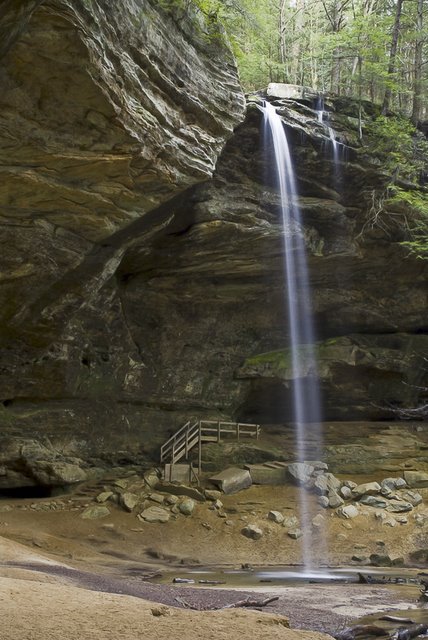Ash Cave, largest recess cave in Ohio, is
part of the Hocking Hills State Park located
on St. Rt. 56 just west of St. Rt. 374. Ash
Cave is one of the main attractions in the
Hocking Hills and a common place for
weddings. Ash cave is also wheelchair
accessible.

Ash Cave gorge is
close to one-quarter mile long and is located in a gorge of Black Hand
Sandstone. Ash Cave resulted from thousands
of years of erosion caused by glaciation and
a tributary, called Queer Creek, flowing
through the gorge. Hocking Hills Black Hand
Sandstone is very porous and erodes easily
compared to other forms of rock. The water
erosion created a seven hundred feet long,
one hundred feet deep, and ninety foot high
recess which is now called "Ash Cave". There
is a picturesque waterfall that falls around
ninety feet.
When early white
settlers discovered the cave they came
across a considerable amount of ashes
receiving the name "Ash Cave". Ash piles
reached one hundred feet long, three feet
deep, and thirty feet wide. The cave was
believed to shelter Indians and the ash
remains were from their many campfires.
Archaeologist has evidence that supports
these theories. The Shawnee Indians used Ash
Cave to rest as they travelled between
today’s West Virginia and Central Ohio. Ash
Cave was used by the early white settlers as
a church, until they could get their own
built.
The 146 acres of
Hocking Hills land was purchase in 1924 by
the State of Ohio. Hocking Hills State Park
was established at that time. The State of
Ohio bought additional land adding Ash Cave
to the Hocking Hills State Park. In 1949,
the Ohio Department of Forestry owned and
operated Hocking Hills State Park. The State
Park is now operated by the Ohio Department
of Natural Resources and the Ohio Division
of Parks.